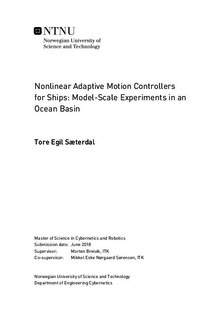| dc.description.abstract | This thesis investigates two different methods of adaptive control, namely L1 adaptive control and Immersion and Invariance adaptive control. The adaptive concepts is used to extend an existing cascaded non-linear feedback control structure. The resulting adaptive control methods are implemented for a 3-DOF ship model and then tested in an purpose-designed simulator and real world conditions in the ocean basin at Marine Cybernetics lab(MC-lab) at the Norwegian University of Science and Technology (NTNU) in Trondheim. Since adaptive methods tend to be more aggressive in control input, a magnitude-rate saturation model and a command governor, two different methods of actuator handling are used to limit this effect and thus reduce energy consumption and actuator wear&tear.Due to problems with the positioning system at MC-lab discovered during the thesis work,a modified velocity estimator was designed, tested and implemented to provide better feed-back signals in the experiments.The experiments and simulations of the adaptive controllers are evaluated using a set of performance metrics that give an objective measure of comparison in terms of control error, energy efficiency and wear & tear, and the adaptive controllers are compared with the nominal controller that they are extended from. The yielded results are promising,as the adaptation proved to reduce control errors and improve reference tracking of theship model, both in simulations and in laboratory experiments. Expecially the L1 adaptive control provides improvement of performance in both simulations and experiments. The Immersion and Invariance adaptive control showed promising results in simulations, but the performance was not as good in laboratory testing. The drawback of the adaptive methods is increased energy consumption and actuator wear & tear, as there is a trade-off between accurate tracking and low energy consumption. | |

